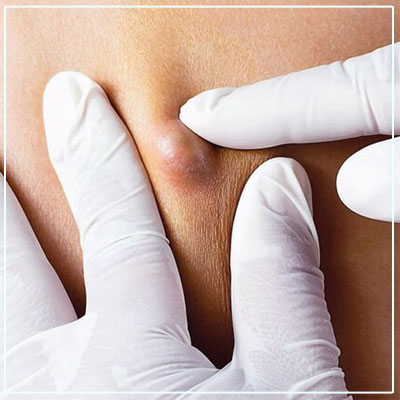Cyst Excision
What is Cyst Excision?
Cysts are closed sac-like structures that may appear anywhere in the body. These sacs may be filled with fluids, semisolids, or gasses. Cyst excision is a surgical procedure that removes a cyst that has developed under your skin. Cysts are harmless small lumps beneath the skin that occur commonly in people. Skin cysts, also known as sebaceous cysts.
Skin cysts are benign, or noncancerous, and rarely cause problems. Unless they become painful or infected, they are normally harmless.

What are the causes of Sebaceous cyst ?
- Sebaceous cysts form as a result of a damaged or clogged sebaceous gland duct, or as a result of a malformed or deformed duct during birth.
- A sebaceous cyst is caused by genetic disorders such as Gardner’s syndrome or basal nevus syndrome.
- Sebaceous cysts form as a result of trauma to the region, which might be a scratch, surgical lesion, or acne.
- Sebaceous cysts may be caused by hereditary disorders such as steatocystoma multiplex.
What are the types of sebaceous cyst?
Sebaceous cysts are often referred to as epidermoid cysts or pilar cysts.
- An epidermoid cyst develops from the epidermis and includes keratin, the protein found in the top layer of skin. However, when cells move inside your skin instead of shedding, epidermoid cysts develop.
- A Pilar cyst is derived from hair follicles and includes keratin.
What does the sebaceous cyst look like?
- Sebaceous cysts are small, spherical bumps or lumps under the skin that are most often observed on the face, neck, back, and abdomen. Cysts may vary in size from 1cm to 5cm.
- On physical inspection, sebaceous cysts feel firmer than normal skin and have a spongy sensation when touched. A tiny blackhead obstructing the cyst’s primary opening, known as the punctum. The cyst contains a combination of fluids that are thick, yellow, and white flakes of keratin.
- If the cyst is more than 5 cm in diameter and showing indications of infection such as redness, discomfort, or pus discharge, it is important to see a dermatologist.
Treatment for Skin Cysts
The majority of the time, skin cysts do not need treatment. They are normally non-cancerous, painless, and harmless until they become painful or infected. Various treatment for cyst are
Medication: Only infected sebaceous cysts may be treated with medication. Skin cysts which have become infected may be treated with antibiotics. Antibiotics may aid in the treatment of cysts by lowering redness, discomfort, and swelling.
Incision and Drainage: In this approach, a small incision is made and the content is softly pushed out. Despite the fact that the procedure is short and simple, the condition often recurs following treatment.
Surgical Removal: Cysts may be surgically removed, especially if the cyst is infectious. Your skin is numbed with local anesthesia before a small incision is made into the cyst and the contents are pushed out. A small scar may form as a result of the operation. Surgical excision of epidermoid and pilar cysts is recommended over drainage techniques since drainage would leave the cysts beneath the skin, causing them to reoccur.
Excision: Excision is classified into two types: Wide excision and minimal excision.
Conventional Wide Excision: To avoid recurrence, dermatologists thoroughly remove the cyst wall or sac from the surrounding tissue. However, the procedure requires sutures and leaves a minimal scar.
Minimal Excision: Dermatologists employ a 2-3 mm incision to thoroughly remove the contents and cyst wall, resulting in minimal scarring and spontaneous healing.
Following cyst removal, the dermatologist will prescribe antibiotic medications and ointment to aid in the healing process. You may also be administered anti-scar lotion to help decrease the visibility of surgical scars.
Laser Cyst Removal: Laser cyst removal procedure is a minimally invasive procedure to eliminate sebaceous cysts, which allows for quicker healing and minimizes the chances of cross infection.
Are there any side effects associated with cyst excision?
Antibiotics and antiseptic, disinfecting ointments may be recommended after the procedure. In the majority of instances, there are no complications or side effects. It is essential that the person takes care of the treated area and avoids exposing it to water for the first few days following the procedure.
What is the healing time of cyst excision?
It will take 1-2 weeks to heal after cyst excision.
For more information & consultation on Cyst excision treatment, visit VIVA Aesthetic Clinic at Opera House or contact us on 022 3573 1556 | 93245 89084 or simply fill in your name and number & one of our team member will get in touch with you soon. Our team of experts along with Dr. Deepam Shah, MD. DNB. FAM – Dermatologist, Cosmetologist & Hair Transplant Surgeon, will help you out in understanding your problem and guide you through every stage of your treatment.
At Viva Aesthetic Clinic, we offer Hair transplant, Aesthetic treatments and skin care with the help of latest technology, world class procedures and a dedicated team led by Dr.Deepam Shah . We are your one-stop clinic in India for comprehensive Hair Restoration, cosmetic laser treatment and skincare solutions.
